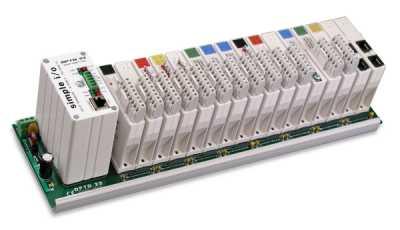SCADA over Ethernet
Support for OPTO 22 SNAP Simple I/O enables remote data communication to Prodigy SCADA over Ethernet networking.
OPTO 22 SNAP Simple I/O is the low-cost, high-quality I/O unit for monitoring, control, and SCADA data acquisition using a wired Ethernet network. SNAP Simple I/O is ideal for SCADA and automated test system applications as well as for remote monitoring applications with high I/O point counts.
The SNAP I/O system combines the common Ethernet networking standard with the universal MODBUS TCP/IP, and OPC protocols to provide an open and convenient method for exchange of process data via a wide area network free of any real distance limitation.
Ethernet networking is the industry standard for company networks, company intranets, and the Internet. SNAP I/O is fully compatible with all of these, using this same technology to provide connectivity to a wide variety of electronic and mechanical devices, such as lights, temperature and pressure sensors, motors, serial devices, and more.
 |
The SNAP I/O system consists of a processor (or "brain") and a range of input and output modules that connect to real world equipment such as thermocouples, pressure and conductivity sensors etc. The system connects to any standard Ethernet network and each sensor or field device can then be accessed through the SNAP I/O system's brain. The brain processes the data and sends it via the Ethernet TCP/IP connection across the network to any Prodigy system connected anywhere else on the network. To minimize system hardware costs Prodigy supports the low cost SNAP-ENET-S64 Snap Simple I/O brain.
A typical SNAP Simple I/O installation consists of a SNAP-M64 mounting rack housing upto 16 SNAP modules, and the SNAP brain. Simple digital and serial capabilities plus full analogue features are available with up to 64 I/O points per rack. SNAP digital modules are all 4 channel, available in both AC and DC configurations. SNAP analogue inputs are two channel or four channel, with up to 14-bit resolution. SNAP analogue outputs are single or dual channel, with 12-bit resolution. All modules have an integral removable terminal for easy installation and removal of field wiring.
Digital module functions include input latching, on/off status, and watchdog timer. Analogue module functions include thermocouple linearization (32-bit floating point for linearized values), minimum/maximum values, offset and gain, scaling, time-proportional output, filter weight, output clamping, and watchdog timer. Serial module functions include the ability to both send and receive ASCII strings to and from attached serial devices, such as chart recorders and barcode readers.
View Prodigy supported OPTO 22 SNAP products.
SNAP Ethernet brain processors come as standard with Modbus/TCP driver that interfaces with any software or hardware that uses the Modbus/TCP protocol. An OPC 1.0 compliant server is available that lets clients using OPC or DDE communicate with one or more SNAP Ethernet based brains. User friendly software is supplied with the SNAP I/O system for configuration of the rack modules and IP address.
The Benefits of Process Data Over Ethernet
- Process data can be broadcast to Prodigy over any distance simply by connecting to the nearest Ethernet network point using common RJ45 cabling. This eliminates the distance restrictions between sensor and computer usually associated with PC based SCADA data acquisition systems and makes remote control via a wide area network free of any real distance limitations.
- Ethernet networking is a common industry standard understood by engineers and does not require training or investment in new technology.
- SNAP Ethernet I/O provides direct 10/100 megabit Fast Ethernet connection, MODBUS/TCP, OPC protocols and a mix of analogue and digital I/O to meet most application needs.
- Upto 8 remote PC's can share data from a single SNAP Simple I/O brain facilitating a level of system redundancy.
- Simple Ethernet connection via standard RJ45 cabling.
- The bandwidth of Ethernet is future proofed with expandability from 10M to 10G.
- Varied network media options such as wireless, optical fiber, or switch, means that media redundancy can be applied to Ethernet.
For more details on the SNAP Ethernet I/O system visit the OPTO 22 website at: www.opto22.com
